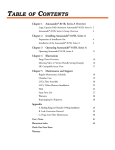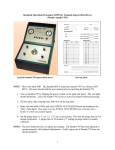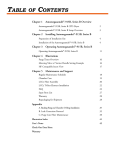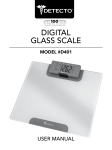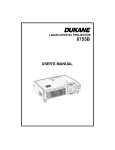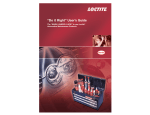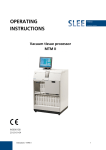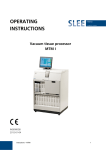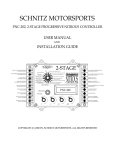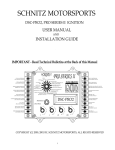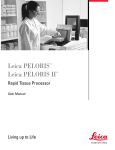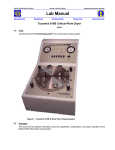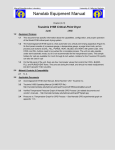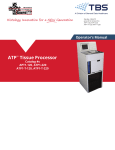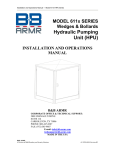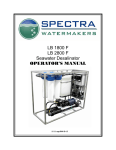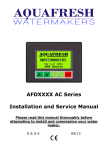Download tousimis® SAMDRI®-PVT-3D
Transcript
TABLE OF CONTENTS Chapter 1 SAMDRI®-PVT-3D Overview SAMDRI®-PVT-3D SAMDRI®-PVT-3D Setup Overview Chapter 2 Installing SAMDRI®-PVT-3D Preparation of Installation Site Installation of the SAMDRI®-PVT-3D Chapter 3 8 Operational Notes Safety Devices Installation Loading Chamber Cooling Solvent Exchange (PURGE) Critical Point Passage (HEAT) Pressure Reduction (BLEED) Typical Cycle Care of Dried Samples Chapter 5 4 4 Operating SAMDRI®-PVT-3D Operating SAMDRI®-PVT-3D Chapter 4 2 3 12 12 12 13 13 13 15 16 16 Theory of Critical Point Drying The SAMDRI®-PVT-3D Preservation of Delicate Ultrastructure Sample drying at the Critical Point (SAMDRI®-ING Method) Transitional Fluid Sample Preparation before SAMDRI®-ING Water Exclusion Chapter 6 Illustrations Chapter 7 Maintenance and Support Regular Maintenance Schedule Chamber Care LCO2 Filter Assembly LCO2 T-filter Element Installation FAQ Optional Accessories Warranty Repackaging for Shipment 17 17 17 18 19 19 21 22 23 24 26 27 30 30 31 Appendix A. Chamber Lamp Replacement Installation B. Purge Line Filter Replacement Instruction C. Installation of the SAMDRI®-PVT-3D (with SOTER™ Condenser) 32 36 38 Illustration Index 50 User's Notes 51 Check Out Data Sheet Warranty CHAPTER 1 ® SAMDRI -PVT-3D Overview SAMDRI®-PVT-3D THE ADVANCED MANUAL CRITICAL POINT DRYER tousimis® Catalog #8755B (SAMDRI®- PVT-3D) Page 2 1 SAMDRI®-PVT-3D Overview SAMDRI®-PVT-3D Setup Overview 1 Remote LCD readout display of LCO2 Tank Weight 2 Main LCO2 Tank ON/OFF Valve 3 Oil/Water Filter Housing of LCO2 Filter Assembly (#8784) 4 T-Filter w/ 0.5µm Element of LCO2 Filter Assembly (#8784) 5 High Pressure Hose, 5ft (other lengths available upon request) 6 COOL / BLEED Exhaust Hose, White (1/4” ID), 6ft 7 COOL / BLEED CO2 Exhaust Vented to either Hood, Exhaust Conduit, or Outdoors. 8 120V Properly Grounded Outlet (from either Wall Outlet or Transformer) 9 PURGE / VENT Exhaust Hose, Clear (1/4” ID), 6ft Exhaust Conduit 1/4” Male Hose Barb 1 3 2 Outdoors 4 PURGE/VENT Exhaust Hose 10 routed to either an Hood 7 Erlenmeyer Flask, a Carboy (1 gal minimum) or Solvent Drain (if available) 5 6 17 11 FILL Meter Valve 16 ∗ 12 COOL Meter Valve 13 BLEED Meter Valve 8 15 14 PURGE/VENT Meter Valve 15 POWER SWITCH 16 HEAT SWITCH TABLE TOP 30”(76cm) Minimum Depth LCO2 Tank Approximately 50% Usable 17 Tare Weight Varies (Consult your LCO2 supplier. Usually stamped on tank) 18 Ceramic Heater or Heater Jacket maybe required in a cold tank placement position 19 Siphon or Dip Tube 20 LCO2 Tank Scale (trc# 8770-54) 9 18 CO2 Gas 12 CO2 Liquid 13 14 10 TABLE TOP 20” (51cm) Minimum Width ∗ At Room Temperature (20°C - 24°C), average LCO2 tank pressure is 800psi (+/- 5%). 11 19 20 Page 3 CHAPTER 2 2 ® Installing SAMDRI -PVT-3D See Appendix C (p.38), to Install SAMDRI®-PVT-3D with optional SOTER™ Condenser (# 8777) PREPARATION OF INSTALLATION SITE Upon receipt of your SAMDRI®-PVT-3D, unpack the instrument carefully and check for any damage that may have occurred during shipment. Report (by Email [email protected] or Fax #301-881-5374) any irregularities immediately to tousimis®. Insist on clean surfaces. Minimum table top space of approximately 20"(51cm) Width x 30"(76cm) Depth should be allotted for the SAMDRI®-PVT-3D with an additional 12"(31cm) x 12"(31cm) of floor space for the LCO2 tank scale (See p.3). • Use bone-dry (min. 99.8% Purity) LCO2 with a syphon (dip-tube) tank* only. • Do not use pressurized LCO2 with Helium or any other high pressure substitute gas. • Properly secure LCO2 tank according to your facility’s safety protocol. * BOC gas suppliers refer to 99.8% purity grade as “2.8” grade. • Always order LCO2 tanks with Siphon or dip tubes. • Air Products gas suppliers refer to 99.8% purity grade as “CP” grade. • Minimum LCO2 purity required is 99.8%. Tank pressure typically reads 800psi (±5%) at room temperature. The amount of LCO2 in tank is best monitored with a LCO2 tank scale (See accessories p.30). Typical nominal LCO2 tank weights for Net 50lb LCO2 tanks: • Full tank: 140 to 170 lbs / Tare of tank: 90 to 120 lbs. • Most of the time, you may use 50% of a 50lb. net weight CO2 tank. • It is good practice to have spare LCO2 tanks stored in reserve in case a tank runs out during mid process. A properly grounded 120V/50-60Hz outlet or Transformer (Step-up/Step-Down) should be located within 4ft (1.2.m)of install site. POWER Connection to SAMDRI®-PVT-3D 1 AC (BLACK) COLD 2 GROUND 120AC/60HZ 3 AC (WHITE) HOT 1 Page 4 2 3 Installing SAMDRI®-PVT-3D INSTALLATION OF THE SAMDRI® -PVT-3D This SAMDRI®-PVT-3D is supplied with the basic accessories for operation with LCO2 as a transitional fluid (for optional accessories, see p.30). ** LCO2 tanks used in most facilities have tare weights ranging from 90 120lbs (40 - 55kg) and are delivered as "full" with net 50lbs (23kg) of compressed CO2. Generally, 50% of the net LCO2 is useable. Monitor the LCO2 tank weight via a LCO2 Tank Scale (#8770-54). 1. Install SAMDRI® within 4 feet (1.2m) of a properly grounded (120V/50-60Hz) electrical outlet. 2. Position a LCO2 tank with dip tube within 5 feet (1.5m) of the SAMDRI®-PVT-3D. For a longer high pressure hose length, (see p.30), trc #8770-33. The LCO2 tank should be mounted on a 400lb (182kg) capacity floor scale w/ remote LCD2 display (trc #8770-54) to easily monitor LCO2 supply**. 3. Pressure gauges or regulators should not be installed between the LCO2 supply tank and the SAMDRI®-PVT-3D LCO2 Connect Inlet. The stainless steel-sheathed high pressure hose accompanying the SAMDRI® is fitted with a CGA-320 female hex coupling which accepts a 3/4" plastic gasket (supplied) and joins the hose directly to the CGA-320 threaded male coupling at the tank top (See p.24). ALL LCO2 tanks should be equipped with a rupture disc. All LCO2 fittings and gasket surfaces should be kept clean and dry. NEVER OVER-TIGHTEN FITTINGS...TUBING ATTACHED MAY BE DAMAGED. Connecting High Pressure Hose to SAMDRI®-PVT-3D 4. Attach the HIGH PRESSURE HOSE onto the LCO2 CONNECT INLET. Gently tighten the High Pressure Female Connector using the two open-end wrenches supplied (one on the hose and the other on the Inlet). Stop at the feel of first resistance; re-tighten if necessary, should you hear a leak. To attach LCO2 highpressure hose end fitting to the PVT-3D “LCO2 Connect”, use the supplied 9/16" and a 1/2" open-end wrenches. First, slide 1/2" wrench over 1/2" fitting as shown in the photo. The 1/2" wrench will be used to hold the “LCO2 Connect Assembly” steady as you gently tighten the high pressure hose end fitting snugly onto each of the flare connects with a 9/16" wrench. DO NOT OVERTIGHTEN NO TEFLON® TAPE NECESSARY High Pressure Hose STEP 1 LCO2 CONNECT INLET STEP 2 9/16" open-end wrench 1/2" open-end wrench STEP 4 STEP 3 Page 5 Chapter 2 5. The tousimis® LCO2 Filter Assembly (catalog #8784) is factory installed directly onto the high pressure hose (See p.24-25). This helps prevent sample contamination from oil, water and particulates. Change the Oil/Water Filter Element (# 8784A) with every 500lbs (226.8kg) LCO2 tanks changes. The secondary 0.5µm T-Filter Element (# 8783B) should be annually replaced. Connecting Exhaust Hoses to SAMDRI®-PVT-3D 6. Attach the 6ft White COOL/BLEED Exhaust Tubing provided to the COOL/BLEED CO2 Exhaust Outlet on the left-hand side of the SAMDRI®-PVT-3D, and the 6ft Clear Exhaust Tubing to the PURGE/VENT Exhaust outlet (See photos below). The tubing should be free of kinks which could block passage of rapidly exiting noisy CO2 gas or solid flakes of CO2. NOTE: It is best to secure both the ends of the COOL/BLEED and PURGE/VENT Exhaust tubing so that the ends do not move during exhaust modes. COOL/BLEED CO2 Exhaust STEP 5 STEP 6 STEP 8 STEP 7 Be careful not to obstruct exhaust hose I.D. when securing. Page 6 PURGE/VENT Exhaust Installing SAMDRI®-PVT-3D Samdri®-PVT-3D Complete Inlet / Outlet Setting 1 LCO2 Connect Inlet 2 COOL / BLEED CO2 Exhaust 3 PURGE / VENT Exhaust 1 2 3 Samdri®-PVT-3D Chamber O-Ring 7. Check chamber, O-ring and windows; inspect unit to insure it is free of dust, oil and moisture. Chamber O-ring is NOT to be greased, but keep the chamber groove clean and dry. NOTE: The chamber O-Ring should lie completely in its groove. NEVER grease the O-Ring. O-Ring (trc #8770-51) should be properly seated and dry prior to placing Chamber lid onto Process Chamber. NOTE: Do not expose chamber to HF or any other Acids. BE SURE TO KEEP CHAMBER O-RING GROVE AND FACE CLEAN AND DRY AT ALL TIMES. Do not use Acetone. Please consult tousimis before using any nonrecommended intermediate fluids or process any nontraditional CPD application material(s) Page 7 CHAPTER 3 3 ® Operating SAMDRI -PVT-3D Turning Power ON / OFF POWER OFF POWER ON 1. Turn power ON. Power light and chamber light will illuminate. Allow SAMDRI®-PVT3D to warm up for 3 minutes prior to use. This allows time for the internal valve heaters to equilibriate. NOTE: Pressure measurement is no indication of the amount of LCO2 left in the tank. The same PSI reading may be noted even after the liquid CO2 drops below the level of the siphon tube. 2. Make certain all metering valves (FILL, COOL, BLEED, PURGE/VENT) are in the closed position (hand tight). Open the main LCO2 tank valve. The Siphon (dip-tube) LCO2 tank should have between 25 lbs - 50 lbs (13.6 kg -23 kg) net weight of LCO2. (Subtract the tare weight of the tank from the tank weight to get the net weight of LCO2). 3. Sample should be dehydrated completely in high purity (99.5+% minimum purity) alcohol. Pour enough high purity alcohol in the SAMDRI® chamber to completely cover your sample(s) prior to transfer. Now, transfer your sample into the process chamber. Make the transfer quickly in order to avoid the samples’ exposure to air and moisture. The chamber O-Ring should lie completely in its groove. NEVER grease the O-Ring. Place the chamber lid down over the chamber using the 3 knurl nuts; tighten each by hand with equal pressure. Never use channel locks or pliers for tightening the knurl nuts. Always hand tight! NOTE: * Use Ultrapure Alcohols only! (i.e. I.P.A., Methanol, Ethanol). Use minimum 99.5% purity Alcohols for best results. Page 8 Operating SAMDRI®-PVT-3D COOL Valve Adjust COOL Valve COOL MODE 4. Open COOL valve to approximately the 0.50 position (See metering valve illustration, p. 21). The temperature of the chamber should drop to near 0°C from room temperature in approximately 1 minute. (The cool rate is a function of the amount of LCO2 running through the COOL VALVE.) Usually a 0.50 setting on the COOL VALVE is satisfactory. It is normal to hear the COOL Exhaust making audible noise as it exhausts from white tubing. Close COOL VALVE when temperature reaches 0°C. FILL Valve Adjust FILL Valve FILL MODE 5. Open FILL metering valve slowly until the chamber is full. LCO2 will enter the process chamber mixing with the high purity alcohol (A bubble (meniscus) will travel across the quartz viewing window indicating the chamber is full). Maintain the FILL valve open to a setting of about 0.50 turns (this setting could vary as per use of the metering valve). Page 9 Chapter 3 PURGE-VENT Valve Adjust PURGE-VENT Valve PURGE MODE 6. Keep FILL valve open. To exchange all the ethanol with LCO2 within the chamber; slowly open the PURGE / VENT metering valve (exhaust) you can visually see movement (from left to right) in the chamber. Make sure the “liquid” level in the chamber is always above the sample. The FILL rate adjust should always exceed the PURGE / VENT rate to insure that the sample remains covered in a liquid state. Place a carboy or an Erlenmeyer Flask at the end of the clear PURGE exhaust tube to collect waste alcohol. Continue in PURGE mode until all of the ethanol is exhausted. To be certain that all the ethanol has been purged, hold a clean piece of paper (glycine paper works best) about four inches from the exhaust tube and collect the solid white CO2 that is being emitted. The solid CO2 will sublime, and any visible “wet” marks on the paper indicates that there is still ethanol remaining. If chamber temperature rises above 10°C during PURGE mode, open the COOL VALVE (this will not interfere with the PURGE mode) until the chamber is cooled to 0°C; then, close the COOL valve and continue purging. 7. After ethanol is purged, close PURGE / VENT metering valve. Keep the FILL valve open to insure chamber is full with LCO2. Note that a meniscus will travel across the viewing window, indicating that the chamber is full. Close the FILL metering valve. Turning HEAT ON / OFF HEAT OFF Page 10 HEAT ON Operating SAMDRI®-PVT-3D Never over tighten Meter Valves when closing to 0.00 position. Over Tightening may damage valves. tousimis® EQUILIBRIUM BLEED MODE 8. At this point, all the metering valves should be in the “CLOSE” (0.00) position (see page 21). Turn HEAT switch ON. HEAT light will go ON. As the temperature (°C) increase, so will the pressure. At approximately 1,350 psi (±5% @ 20°C), the pressure relief valve will begin to vent the chamber pressure. The chamber’s pressure will be maintained above the critical pressure for CO2 (1,072 psi). As the temperature passes the critical temperature for CO2 (31°C), the heater will cut off (indicated by the heat light turning OFF) between 33°C 39°C. The temperature may coast up to 44°C; this is normal. Do not turn off the HEAT switch. The SAMDRI®-PVT-3D will automatically maintain the chamber at a temperature higher than the critical temperature (31°C) of CO2. 9. At this point, the SAMDRI®-PVT-3D is above the critical pressure (1,072 psi) and temperature (31°C) for CO2. It can maintain itself automatically at the tousimis® equilibrium state indefinitely. For best results, we recommend that you wait 4 minutes in equilibrium before proceeding to BLEED mode. 10. POWER and HEAT switches are ON. FILL, COOL, BLEED and PURGE / VENT metering valves are closed. Slowly open the BLEED metering valve to the BLEED meter valve adjust position noted on the Check-Out Data Sheet. The initial BLEED flow rate via the flow meter should be 8-10 SCFH (Fast decompression could result in CO2 “condensation”). Chamber heater will cycle ON and OFF automatically to maintain temperature above the critical temperature during BLEED. Close BLEED metering valve at 400psi. BLEED Valve Adjust BLEED Valve SAMDRIed samples could be hygroscopic; coating with conducting film immediately will best preserve surfaces of interest for your studies. However, even after coating with a conducting metal layer < 100Å thick, your sample should be kept dry and clean. 11. Open the PURGE / VENT metering valve to at least 0.50 setting to reduce chamber pressure to 0 psi. The pressure will reach 0 psi (atmospheric pressure) in 2-3 minutes, loosen the 3 Chamber Knurl Nuts evenly, by hand. Remove your sample and store in a dry environment (i.e. vacuum, desiccator, etc) for further processing. 12. You may begin your next process run immediately (if desired). 13. After last process run of the day, make certain the chamber is clean and O-ring is in place. Place lid on and tighten (by hand). Close the LCO2 main tank valve and open all valves of the SAMDRI® to “drain” them from any residual line pressure, then close all the valves. Clean the SAMDRI® surfaces. Turn Power OFF. Page 11 CHAPTER 4 Operational Notes 4 SAFETY DEVICES The SAMDRI®-PVT-3D sample process chamber is a high pressure metal alloy vessel with viewing ports designed to withstand the pressures used in the critical point drying process. To ensure additional operator safety, the following features are incorporated: • A mechanical Automatic Pressure Control System (APCS) which will maintain the chamber at a pressure between 1,350 psi ±5% (see Check-Out Data Sheet for your dryer’s pressure relief valve specs). • A rupture disc which will be activated (2,000 psi at 20°C) if the mechanical APCS should fail (see factory check-out data sheet for the setting(s) of your unit.) • Quartz ports which will crack along the crystal line, rather than shatter, should they become unduly stressed (Immediately replace chamber lid if window becomes cracked). • Metal-alloy (sintered stainless steel) filters placed internally along both the inlet and exhaust paths, preventing solid particles from fouling the gas lines/valves/fittings. • An electronic heating system which is governed by two thermostats: one to maintain the chamber during critical point passage at temperatures 37°C ± 2°C (see factory check-out data sheet for your unit) and a second safety thermostat to shut off all heating should a failure bring the chamber temperature near 49°C ± 3°C. • A bulb and a translucent diffuser plate below the sample chamber which illuminate chamber contents for easy viewing. INSTALLATION The SAMDRI®-PVT-3D is supplied with all necessary internal accessories for operation with pressurized LCO2 as a transitional fluid. The user may also find it helpful to mount the LCO2 cylinder on a tank scale (#8770-54) to monitor transitional fluid supply (by weight, not pressure!), since only approximately 50% of the original net LCO2 may be used. The SAMDRI®-PVT-3D connects to a standard 120V/50-60Hz, 15 Amp grounded outlet and can be used wherever space permits. Waste alcohol can be collected into a carboy or an Erlenmeyer Flask before the venting of the CO2 commences. The work area should be clean and dry at all times. LOADING Methanol may also be used as an intermediate fluid Page 12 An adequate amount of intermediate fluid (Ultrapure Alcohol*, 99.9%+, enough to cover the sample and holder) should be poured carefully into the chamber before placing your samples into the chamber. This will minimize surface evaporation of the dehydrating intermediate fluid (ethanol) from the sample. This is done at room temperature to avoid moisture absorption from the atmospheric environment. Operational Notes CHAMBER COOLING The tousimis® cooling capability of the SAMDRI®-PVT-3D may be exercised at any time, for it is an entirely independent operation from FILL or PURGE/VENT. The chamber is brought down to a temperature of approximately 0°C or below (Consult Check-Out Data Sheet for your unit). The LCO2 tank should have at least 50% net weight of LCO2 for proper COOL operation. Chamber cooling is necessary to ensure filling with the liquid phase of the transitional fluid (LCO2). Cooling also insures expulsion of the gas phase ahead of the liquid phase in the pressure hose connecting the transitional fluid tank to the SAMDRI®-PVT-3D inlet circuit. CO2 exiting from the COOL/BLEED Exhaust hose may appear in solid flakes as it encounters the lower pressure environment. A 6ft (1/4” I.D.) white static free exhaust tubing reduces the noisy rapid expansion of the LCO2 exhaust. This is a standard accessory. SOLVENT EXCHANGE (PURGE) SUGGESTED TEST TO VERIFY COMPLETION OF PURGE: Since more adiabatic cooling usually takes place near the exhaust orifice of the unit (evidenced by white flakes of CO2, which will form at -79°C), and since intermediate fluids such as pure ethanol have even lower freezing points, these fluids will be flushed out as liquids. A soft, dry coated paper held momentarily in the exhausting stream will catch the white solid flakes of CO2, and when shaken out, will show "wet" spots and indicate that there is remaining alcohol to be purged. After cooling the chamber, transitional fluid (LCO2) may now be allowed to simultaneously enter and leave the chamber. This process mode of incoming LCO2 and outgoing alcohol and CO2 is called PURGE. Characteristics visible to the operator during the PURGE mode are as follows: • The intermediate fluid (alcohol) will appear as “oily currents” (schlieren patterns) within the chamber (especially forwards the onset of PURGE). • The intermediate fluid will appear as a liquid or a slurry when exiting through the clear PURGE Exhaust hose. Once thoroughly exchanged, the chamber liquid will be perfectly clear; the exiting CO2 will be solid white. The Purge rate is manually adjustable with the PURGE / VENT valve, and should be set by the operator to allow for a steady flushing of transitional fluid without letting the liquid level drop away from the top chamber window. A warming trend will be noted during the PURGE mode since the incoming fluid originates at room temperature. The operator should occasionally check the chamber temperature, and open the COOL valve as necessary, ensuring that the purging continues in the liquid state. It is best to keep the temperature between 0°-10°C during the PURGE mode. The purge time required for complete solvent exchange is not standardized, but is dependent upon the size, density, and cellular characteristics of the sample. Exchange in a mono-layer of cells can be completed within several minutes, whereas large semipermeable structures may require 15 minutes. Generally, 24 samples of a size 4mm x 6mm x 2mm accommodated by a Sample Holder (tousimis® catalog #8763) will require about 10 minutes; these purge times are only suggested, however, and should be established in each case by process operator. CRITICAL POINT PASSAGE (HEAT) When all the intermediate fluid permeating the sample has been replaced by LCO2, purging and cooling are terminated. Make sure the chamber is completely filled with LCO2. Return to FILL again, if necessary. Heat is now applied to the chamber, elevating the transitional fluid to above its critical temperature and pressure. During the HEAT mode, the CO2 may appear as oily currents due to the heat causing variations in LCO2 densities and thus the Page 13 Chapter 4 Schlieren pattern appearance. NEVER use a LCO2 tank if it is kept outside in the winter. Bring it to room temperature for 2-3 days before use; otherwise, due to low LCO2 tank temperature, the tank will not supply the SAMDRI® with LCO2 at the proper pressure. The HEAT mode is thermostatically controlled to maintain a temperature at a safe margin above the critical values, yet low enough that thermal destruction (above 55°C) of any biological sample does not occur. The chamber pressure increases relative to the increase in temperature. It is likely that the critical pressure will be reached before the critical temperature if the chamber was completely filled with LCO2 when heat was applied. The APCS is factory-set for 1,350 (±5% @ 20°C) (see factory check-out data sheet) and will keep the chamber below 1,600 psi until the chamber temperature rises above the critical temperature. Typical Paths that Critical Point Passage May Follow During "Heat Mode" 2000 Safety Control (Rupture Disk) 1800 SPCM 1400 1200 1072 psi CO2 Critical Pressure 1000 Automatic Temperature Control CO2 Critical Temperature Chamber Pressure (psi) 1600 800 600 Pressure range of Liquid CO2 at room temperatures (700psi - 900psi) 400 200 HEAT ON 0 5 10 15 20 25 30 31.3°C 35 Chamber Temperature (°C) Page 14 40 45 50 Copyright tousimis® Operational Notes PRESSURE REDUCTION (BLEED Mode) Once the critical point has been passed with an adequate margin of safety, the CO2, which is now in a dense vapor state, is exhausted slowly from the process chamber. TEMPERATURE (°C) Typical Chamber Temperature during Pressure Reduction (BLEED) 44 42 40 38 36 0 1 2 3 4 5 6 7 8 9 10 11 12 TIME (Minutes) Typical Range of Paths that Pressure Reduction May Follow in the SAMDRI®-PVT-3D 1400 CHAMBER PRESSURE (psi) 1200 1000 800 At 400 psi, VENT mode may be activated. 600 400 200 0 0 1 2 3 4 5 6 7 8 9 10 11 12 13 14 15 16 17 18 19 20 21 22 23 24 TIME (Minutes) Page 15 Chapter 4 TYPICAL PROCESS CYCLE A typical process cycle, including 7 minutes of purge time, might run for about ½ hour, as shown in the following, and may use 1.5lbs (0.7kg) of CO2. Typical Drying Cycle TIME (minutes) 0 COOL Load FILL Cool 5 Fill PURGE (from 5 to 10 minutes) Purge TYPICAL SAMDRI®-PVT-3D DRYING CYCLE 12 Critical Point Passage HEAT Pressure Reduction 26 BLEED SAMDRI Modes VENT 36 Copyright tousimis® CARE OF DRIED SAMPLES After drying, care should be taken to prevent damage to the sample surfaces. It is * Note that the SAMDRIed recommended that the sample be attached* to a tousimis® 10 mm diameter or Cambridge Biological samples could 1/2” stud and, as soon as possible, coated with the appropriate conducting layer. SAMDRI®absorb certain glues! DO ed biological samples are receptive to a metal coating in a vacuum and do not require any NOT USE glue to mount preparatory carbon coating. If the sample cannot be further processed immediately after your sample since it will drying, it should be stored in an isolated and desiccated environment. After coating, samples diffuse into the dried should be maintained in a dry environment to prevent changes as a result of water absorption sample. or possible cracking of the coating layer. Page 16 CHAPTER 5 Theory of Critical Point Drying 5 THE SAMDRI®-PVT-3D The tousimis® SAMDRI®-PVT-3D is a critical point drying apparatus which through a series of stages, the sample is processed by a technique which preserves and stabilizes the delicate 3-D morphology without freezing "rigid" chemical fixation (which alters the ultra-structure) embedding (paraffin, plastics, epoxies, etc.). PRESERVATION OF DELICATE ULTRASTRUCTURE Sample Drying (SAMDRI®) at the Critical Point: In order to preserve 3-D structure, one must avoid the sudden (air-drying) change of densities that occurs when the fluid "embedding" the sample and permeating its ultrastructure is converted to gas. Most liquids used to replace water in samples have a well-defined critical point -- a specific pressure and temperature at constant volume for each of them. At the critical point the densities of the gas and liquid phases of the transitional fluid are equal; therefore, a phase boundary does not exist. After the critical point transition from the liquid to vapor phase has taken place, the vapor phase can be removed (while above atmospheric pressure) and the dried sample preserved without structural damages due to surface tension forces. SAMPLE DRYING AT THE CRITICAL POINT (SAMDRI®-ING) METHOD SAMDRI®-ING involves immersion of the sample in an intermediate fluid [ethanol] and its substitution with LCO2, under pressure. The LCO2 is automatically converted to its gaseous phase at the critical point in the high pressure chamber and removed at temperatures higher than 31.1°C, thereby avoiding the distortion resulting from evaporation boundaries or thermal expansion. Typical Paths that Critical Point Passage May Follow during "Heat Phase" (p. 14) shows the isotherm for CO2, including the critical isotherm at 31.1°C. Superimposed is a path which an average critical drying cycle (SAMDRI®) can follow, divided here into four stages: 1st, the process chamber is COOLED and FILLED with LCO2, and maintained at 0°C ± 10°C; 2nd, the sample in the alcohol under pressure is PURGED of the alcohol with LCO2 until all traces of intermediate fluid [alcohol] are removed; 3rd, the chamber is heated automatically to a temperature above the critical temperature of CO2. While the chamber volume is constant, there is an accompanying rise of pressure to above the critical pressure of CO2, and the liquid phase is converted to the gaseous phase; 4th, the gaseous CO2 is exhausted at a temperature above 31°C from the process Page 17 Chapter 5 chamber, returning the sample to conditions of room temperature and pressure. The sample is now critically point dried and ready for coating (metal film coating under vacuum) and subsequent study in the SEM, TEM or electron probe X-ray microanalyzer. Isothermal of Carbon Dioxide and an Average Drying Path of Sample in the SAMDRI®-PVT-3D Isotherms psi atm 200 2700 50°C PRESSURE (CO2) 2400 2100 Pressure Reduction Bleed & Vent 150 1800 1500 100 1200 Critical Point 900 600 42°C 31.2°C 20°C 10°C 0°C Critical Point Passage 50 300 Cool, Fill, & Purge .1 BEGIN Sample in intermediate fluid: ethanol or methanol (for non-bio-samples) at room temperature and atmospheric pressure. .2 .3 .4 END (After 35 minutes average time) Dried sample now is in air at room temperature and atmospheric pressure. Transfer to moisture-free container. .5 .6 .7 .8 DENSITY (CO2) g/cm3 .9 1.0 Possible paths during SAMDRI®-ing Based on data by tousimis® TRANSITIONAL FLUID Liquid Carbon Dioxide (LCO2) is the preferred transitional fluid in critical point drying, since it is easily accessible, more economical, less noxious, safe in a well-ventilated laboratory, and provides more consistent results than any other transitional fluid. Only research grade or filtered (see tousimis® combination filter, catalog #8784) "bone dry" LCO2 should be used. Use of LCO2 requires a "dip" or Siphon tube in the CO2 cylinder tank, which provides liquid at the tank outlet for the first 25-30 lbs. Tanks should be kept at room temperature for at least 2-3 days prior to use. Page 18 Theory of Critical Point Drying LCO2 is shipped to your laboratory by your local distributor in steel cylinders. Please note the tare weight and gross weight. You can only use about 50% of the net LCO2 since the dip tube does not reach the bottom of the tank. Advise your supplier to never wash the empty steel cylinder with water or leave it "in the yard" to accumulate pollutants. ALWAYS KEEP SPARE FULL TANK IN RESERVE AT ROOM TEMPERATURE. As you receive the LCO2, it is under pressure at 20°C, 750 to 900 psi. [While CO2 is a respiratory stimulant, humans cannot breathe air containing more than 10% carbon dioxide (at this level one could faint)]. Use the SAMDRI®-PVT-3D in a well-ventilated room, or exhaust all CO2 into a working hood, exhaust conduit or the outdoors. Please consult your laboratory regulations for exhaust requirements. Usually one to two pounds of LCO2 are used for each process run. The critical temperature and pressure of pure CO2 are 31.3°C (88.84°F) and 72.9 atm (1072 psi), respectively. SAMPLE PREPARATION BEFORE SAMDRI®-ING It is not the intention of this manual to present an extensive review of sample preparation techniques. Certain samples present special problems in preparation and it is the responsibility of the investigator to determine the best procedures in each case. It is the general object of pre-critical point drying preparation steps to yield a sample in which the histological ultrastructure is well-stabilized and free of water. Most biological samples preparation could include: FIXATION - Fixation generally utilizes an aldehyde such as formaldehyde*, glutaraldehyde*, or acrolein** to provide rapid inter- and intra-cellular penetration and fixation, followed by osmium tetroxide for further fixation. * High purity or ultra-pure fixatives are recommended. (see tousimis® CAT. #1008 and #1011) ** Acrolein is a very hazardous chemical. Avoid its use unless there is no other alternative, and then use as per special instructions in your laboratory and after careful reading of the MSDS. STAINING AND SPECIAL TECHNIQUES - A fixative/stain such as aqueous solutions of osmium tetroxide or silver is employed for SEM samples prior to dehydration and critical point drying. DEHYDRATION - The fixed sample is taken through a series of increasing concentrations of a liquid such as ethanol, ending in a 100% ethanol of the highest possible purity (tousimis® CAT. #5086). Transfer to room temperature before placing it in alcohol in the SAMDRI®PVT-3D chamber, and seal. Then you may initiate the process run. WATER EXCLUSION Water or oils remaining on the sample during critical point drying will not pass through the critical point with the transitional fluid (since their critical pressures and temperatures are different). Instead the water will evaporate from the sample surface and cause damage, or the oils will cover the surface and render sputtering or shadowcasting with an electrically conducting element impossible. Therefore, the sample must first be completely dehydrated, as mentioned above, and precautions must be taken to avoid subsequent rehydration before critical point drying (SAMDRI®-ING). Page 19 Chapter 5 The final dehydration step involves three conditions for the 100% dehydrating liquid: 1. The dehydrating liquid should fill the vessel containing the sample in order to reduce exposure to atmospheric moisture outside the SAMDRI®-PVT-3D. Avoid the use of powdertype CaSO4 dehydrants in the ethanol. We suggest the use of clean silica gel-type dehydrants to avoid sample contamination from "powdering" CaSO4 crystals. 2. The vessel should then be tightly stoppered with the lid (hand tighten). 3. The 100% fluid should be obtained from a newly-opened bottle of ultra-pure ethanol or that it contain a dehydrant to insure no water contamination. ALCOHOL IS HYGROSCOPIC. General Form of Phase Boundaries Pressure vs. Temperature for CO2 PRESSURE Liquid Solid Pc = 1072psi Critical Point of CO2 Triple Point ima subl ti o n Gas Tc = 31°C Pc = Critical Pressure of CO2 Tc = Critical Temperature of CO2 Page 20 Temperature Copyright tousimis® CHAPTER 6 6 Illustrations Metering Valve w/ Vernier Handle Setting Example The numerical markings are arbitrary numerals for the sole purpose of meter valve adjustment position reference. 1 complete counterclockwise 360 rotation from the 0.00 starting position is referred to as the '0.25 position'. 0.00 Setting 0.50 Setting 1.00 Setting Venting Precautions LCO2 Inlet Connect COOL/BLEED CO2 Exhaust PURGE/VENT Exhaust #8784 LCO2 FILTER ASSEMBLY LCO2 Tank Only use Flow Meter to measure flow at onset of BLEED mode only. 6ft (180cm) 6ft (180cm) SCFH VENT TO HOOD, EXHAUST CONDUIT OR OUTSIDE DURING PURGE; COLLECT WASTE ALCOHOL INTO A CARBOY (1 GAL MINIMUM) , AN ERLENMEYER FLASK OR SOLVENT DRAIN PURGE / VENT EXHAUST HOSE CLEAR TUBING, 6ft 20 16 12 8 4 0 COOL/BLEED EXHAUST HOSE WHITE TUBING, 6ft FLOW METER USED TO CALIBRATE FLOW AT ONSET OF THE BLEED CYCLE. SET FLOW RATE to 8-10 SCFH Page 21 CHAPTER 7 7 Maintenance and Support Regular Maintenance Schedule Maintenance Activity Recommended Frequency Manual Reference trc® Catalog Number Keep Chamber Clean and Dry Always p. 23 N/A Replace LCO2 Tank After 50% net p. 28 (FAQ) tank consumption Contact local supplier Replace LCO2 Oil/Water Filter in LCO2 Filter Assembly 500lb LCO2 Use p. 24-25 # 8784A Replace T-Filter Element in LCO2 Filter Assembly 1 Year* p. 26 # 8770-83B Chamber O-Ring 3 Months* p. 7 # 8770-51 Internal Purge Line 0.5µm Filter 6 Months* p. 36-37 # 8770-83 * May Vary Depending on Usage. Page 22 Maintenance and Support Chamber Care NOTE: * Use Ultrapure Alcohols only! (i.e. I.P.A., Methanol, Ethanol). Use minimum 99.5% purity Alcohols for best results. * Ult rapure Alcohol Us e only hol high purity alco LINT FREE WIPES 99.5%+ NOTE: Do not expose chamber to HF or any other Acids. Do not use Acetone. Please consult tousimis before using any nonrecommended intermediate fluids or process any nontraditional CPD application material(s) NOTE: BE SURE TO KEEP CHAMBER O-RING GROVE AND FACE CLEAN AND DRY AT ALL TIMES. ACETONE HF VACUUM GREASE NEVER INTRODUCE ACIDS INTO CHAMBER Page 23 Chapter 7 LCO2 Filter Assembly THE tousimis® LCO2 FILTER ASSEMBLY (# 8784) ( 4 + 5 Figure Shown Below) Part B Installation Instructions 1. Uncouple CGA-320 S.S. nut from LCO2 tank. Close main tank valve. Crack S.S. nut and bleed line pressure. Make certain there is no pressure within the high pressure hose. Tighten Hole if Needed 2. Install filter element as shown in the diagram. (#8784A) Push element steadily into upper housing orifice until slight resistance is felt. Screw housing (Part B) onto upper housing (Part A). Be sure that teflon® O-Ring is in place. Rotate to Tight 3. The 0.5 µm T-Filter Element (# 8770-83B) is pre-installed into T-Filter. * Change LCO2 Filter Element (#8784A) with every 500 lbs of LCO2 consumption, change T-Filter Element (#8770-83B) every 1 year to insure proper filtration. 1 2 4 5 3 LCO2 Filter Element #8784A Oil/Water Filter Housing O-Ring #8784B 8 LCO2 Tank w/ Siphon Tube 6 1 Main LCO2 Tank Valve 2 Gasket (Teflon® or Nylon) 3 CGA - 320 S.S. Nipple 4 Oil/Water Filter Housing w/ LCO2 Filter Element (#8784A) Page 24 7 5 T-Filter with T-Filter Element (0.5 µm, #8770-83B) 6 CGA - 320 S.S. Coupler Nut 7 Teflon® tape 8 High Pressure Hose to Samdri® IN OUT Part A CAUTION: USE tousimis® LCO2 FILTER ELEMENT (trc# 8784A) ONLY. Operating pressure not to exceed 1000 psi Maintenance and Support LCO2 Filter Element Installation (#8784A) STEP 1 After all of the pressure is safely bled from high pressure line, unscrew Oil/Water Filter Housing by hand. STEP 4 Place new LCO2 Filter Element (#8784A) into lower Oil/Water Filter Housing. Let gravity hold element in place. STEP 5 Carefully lower Oil/Water Filter Housing over replacement element (#8784A). STEP 2 Remove Oil/Water Filter Housing. STEP 3 Position LCO2 Filter Element (#8784A) into center of lower Oil/Water Filter Housing. STEP 6 Hand tighten the housing body together firmly. O-Ring seats properly. Open main tank valve and check for leaks. Page 25 Chapter 7 LCO2 T-Filter Element Installation (#8770-83B) STEP 1 STEP 2 After all of the pressure is safely bled from high pressure line, unscrew T-Filter cap using wrench. STEP 4 T-Filter Gasket (# 8770-83D) Carefully remove T-filter element. STEP 3 T-Filter Element (# 8770-83B) Top view of correctly installed T-Filter. STEP 5 Install a new T-filter element (#8770-83B) into center of T-filter housing. STEP 6 NOTE: Do not over-tighten T-Filter Cap. Hand tighten T-filter cap. Page 26 Use wrench, tighten the T-filter cap firmly. Open LCO2 tank valve and check for leaks. Maintenance and Support FAQ Should the LCO2 tanks be secured? YES. It is recommended that: The LCO2 Tanks be placed onto LCO2 Tank Scales (trc #8770-54) and secured as per your facility safety regulations. Monitor the net LCO2 used. When you approach 50% LCO2 consumption, it is recommended that you replace the LCO2 tank with a new one. Always keep several spare tanks of LCO2 in reserve. Do I need an In-line regulator between the tank and the SAMDRI®-PVT-3D? NO. A regulator is not needed between the LCO2 tank and the 3D. The 3D is designed to simply operate from LCO2 direct tank pressure. Is the chamber necessary to heat during BLEED mode? YES. During the BLEED mode the HEAT switch should be kept ON. The HEAT mode will maintain chamber temperature automatically above 31ºC and keep the process chamber dry. How do I replace the #8784A filter elements? To replace #8784A filter element, loosen and remove lower part B by turning counter clockwise. Remove old element and replace with new (See illustration p.24-25). How do I secure the chamber lid? Evenly finger-tighten the chamber lid with the 3 Knurled Nuts. Use even and steady finger pressure on all Knurl Nuts alternatively. Never use a non compatible tool or excessive force (i.e.: never use a wrench, etc). Should I use “High-Pressure Head” tanks such as Helium or other high-pressure gases? NO. Never use high-pressure tanks. Typical proper pressure range for LCO2 tanks are between 750 – 900 psi. Higher pressures may damage SAMDRI®-PVT-3D and / or cause failures. Can I use lower purity alcohol or acid in chamber? NO. ONLY USE ULTRA-PURE ALCOHOL (ETHANOL, METHANOL, I.P.A., etc.) IN CHAMBER, NEVER ANY ACID! CONTACT TOUSIMIS PRIOR TO USING ANY OTHER INTERMEDIATE LIQUIDS. Is a siphon or dip tube type LCO2 tank necessary? YES. It is essential that the LCO2 tank has a siphon or dip tube on order to deliver liquid and not gaseous CO2. The SAMDRI®-PVT-3D will not operate properly without liquid CO2. Page 27 Chapter 7 Why can I only use 50% of the net amount of LCO2 and not 100% of the net LCO2 within a new LCO2 tank? LCO2 is lost during the process for 2 reasons: 1) As the liquid level drops in the LCO2 tank, the gaseous head space created as the liquid level drops is taken up via gaseous CO2 molecules. 2) Siphon (aka: dip-tubes) does not reach the absolute bottom of the LCO2 tank. What can I do to check that the BLEED rate is properly set should it appear unusually slow? The flow rate should read 8 - 10 SCFH at the onset of the BLEED cycle. This setting should yield at average of approximately 100-150 psi/min reduction in pressure. This pressure reduction flow rate is the desired decompression rate between 1300 → 400 psi to avoid condensation. You may periodically measure the BLEED rate (if desired) via the Flow Meter supplied by attaching the Flow Meter to the COOL/BLEED CO2 Exhaust Outlet via a short (approximately 2') piece of Tygon tubing. Flow Meter What is the average FILL Time? The FILL time should not exceed more than 2 minutes. Typically the chamber will FILL in less than 1 minute. What is the average PURGE time? The PURGE time will vary according to the volume of ethanol in the chamber. It takes approximately 7 minutes to purge 50% of the chamber volume (10-15ml Alcohol). Page 28 Maintenance and Support Is chamber pressure automatically regulated during Critical Point Passage? YES. Chamber pressure will rise above 1072psi (Critical Pressure for CO2) and automatically vent internally at 1350psi ±5% @ 20°C. Is chamber temperature automatically regulated during Critical Point Passage? YES. Temperature is maintained between 31°C-42°C automatically with HEAT switch ON. Is there back-up pressure Safety? YES. In addition to automatic internal pressure venting above the Critical Point. There is a “rupture disk” which automatically vents entire system at 2000psi. What grade LCO2 is best for the SAMDRI®-PVT-3D? 99.8% minimum purity. May I replace or add parts without authorization from tousimis®? NO. SAMDRI®-PVT-3D is a high pressure instrument with specific tolerances engineered into the design. Please contact tousimis® for authorization prior to attempting any desired changes. What should I do if the initial COOL time is suddenly much slower than normal? 99% of the time the reason for this is lack of Liquid CO2. The SAMDRI® is designed to COOL the process chamber via Liquid CO2 and not gaseous CO2. Reasons that typically explain gaseous CO2 delivery: 1) The Liquid CO2 level has dropped below LCO2 tank siphon (aka: dip tube) and only gaseous CO2 is being delivered. [Note: The best way to monitor LCO2 is via weight and not pressure. It is best to monitor tank weight via a "LCO2 tank scale (trc#8770-54)”] 2) Gas supplier has delivered Gaseous rather than Liquid CO2 by mistake. This can happen as the 2 tank types may look identical and the delivery/loading Gas Company staff accidentally delivered the wrong tank type to your site. The simpler solution is to replace the existing supply tank with a new LCO2 tank and initiate COOL mode. If the same problem persists; please contact customer service at either [email protected] or via tel# 301-881-2450. Page 29 Chapter 7 OPTIONAL ACCESSORIES Catalog # Description 8777 SOTER™ CONDENSER 8760-01 Knurl Nut 8760-40 5 AMP Fuse 8770-10 Lamp, 120V/60Hz volt 8770-32 High Pressure Hose, 5 ft 8770-33 High Pressure Hose, 10 ft 8770-HPS High Pressure Hose, Custom Length Up To 10m (33ft) 8770-45 Flow Meter - Use with any 1.25" dia. Samdri® Chamber (20 SCFH) 8770-50 Chamber Lid 8784 LCO2 Filter Housing for 8784A Filter Element 8784A Replacement LCO2 Filter Element for 8784 Filter Housing 8784B O-Ring for 8784 Filter Housing Seal 8784-05 Gasket for LCO2 Tank Connect 8770-83 Internal 0.5µm Brass Particulate Line Filter 8770-51 O-Ring for 1.25" Diameter Autosamdri® Chamber 8770-53 Power Cable, three prong, 120V/60Hz 8770-54 LCO2 Tank Scale, w/ Remote LCD Display (400lb capacity) 8770-55 LCO2 Tank Heater 8770-56 Step-Down Transformer, 220V → 110V 8770-57 Step-Up Transformer, 100V → 120V, 50/60hz 8761 Grid Holder, holds 12 grids. 8762 12 Sample Holder, each compartment measures 7.5 (dia.) x 6mm (ht.) 8763 24 Sample Holder, each compartment measures 4.5 (dia.) x 6mm (ht.) 8764 4 Sample Holder, each compartment measures 9 (dia.) x 16mm (ht.) 8766 Cover Slip Holder, for 9mm to 13mm diameter Glass Cover Slips 8766-01 Washer for Glass Slip Holder (for use with #8766) 8766-02 Stainless Steel Screens for Cover Slip Holder (for use with #8766) 8767 Cover Slip Holder, for 16mm to 22mm diameter Glass Cover Slips 8767-01 Washer for Glass Slip Holder (for use with #8767) 8767-02 Stainless Steel Screens for Cover Slip Holder (for use with #8767) Contact tousimis @ 301-881-2450 or [email protected] for current pricing and availability, or visit our web site at www.tousimis.com. Page 30 Maintenance and Support WARRANTY The SAMDRI®-PVT-3D is warranted to the original purchaser for two years from date of purchase against any defect in materials or workmanship. Should you have any questions, please feel free to contact us. If it is determined that the unit should be returned for repairs to our Service Department, we will send a written authorization for shipment. Parts and labor are free of charge; shipping charges are to be paid by customer (insure instrument at current list price). DO NOT ship instrument via U.S. Mail. Use UPS, FedEx or other qualified shippers only. Our mailing address: tousimis research corporation 2211 Lewis Avenue Rockville, Maryland 20851 USA Our shipping address: tousimis research corporation Attention: Instrument Service Department 2211 Lewis Avenue Rockville, Maryland 20851 USA Telephone # 301-881-2450 Fax #301-881-5374 Email: [email protected] REPACKAGING FOR SHIPMENT After authorization for repairs is received (see warranty), this general rule may be followed in repackaging a tousimis® instrument for shipment: a) Attach identification tag to instrument. Tag should indicate owner name, the model and 4-digit serial number of the instrument, and the type of the service or repair desired. b) Secure chamber lid over a properly seated O-ring and tighten 8-knurl nuts evenly. Do not send the high-pressure hose or electrical power cord. c) Place instrument in original container, if available. If original container and packaging material is not available, new packaging may be purchased from tousimis If original container is not used, d) Wrap the instrument in bubble plastic. e) Protect panel faces and instrument sides with foam or appropriate non-abrasive cushioning material. Use a minimum 6” of shock-absorbing packing material around all points of the instrument. Two double walled boxes are suggested for shipment; BOX-WITHIN-A-BOX AT 350LBS. TEST STRENGTH. f ) Use heavy duty shipping tape or metal bands to seal container. g) Mark shipping container with "Delicate Instrument, Fragile", etc. and insure it. Page 31 APPENDIX A Chamber Lamp Replacement Installation A 1. Turn the power switch "OFF" and unplug 120V power cord from the SAMDRI®-PVT-3D. 2. Disconnect 'PURGE / VENT’ Exhaust Hose from the SAMDRI®-PVT-3D. PURGE / VENT Exhaust Hose 3. Disconnect 'COOL / BLEED’ Exhaust Hose from the SAMDRI®-PVT-3D. COOL / BLEED Exhaust Hose Page 32 Chamber Lamp Installation 4. Close main LCO2 tank valve, bleed LCO2 High Pressure Hose. Disconnect 'LCO2 High Pressure Hose' using supplied 9/16" Wrench and 1/2" Wrench from the SAMDRI®-PVT-3D Connect Inlet. Main Tank Valve 9/16” Wrench LCO2 High Pressure Hose LCO2 Tank with Siphon Tube 1/2” Wrench 5. Carefully pick up the front end of SAMDRI®-PVT-3D and gently rest on its back end. 6. Unscrew the 4 black rubber legs that secure the access panel in place. Page 33 Appendix A 7. Remove and set aside the access panel. Note access panel orientation so that you may reinstall panel in the same direction upon procedure completion. Access Panel 8. Locate the Chamber Lamp as indicated below. SAMDRI®-PVT-3D Chamber View Chamber Lamp (Cat# 8770-10) Page 34 Chamber Lamp Installation 9. The Chamber Lamp is mounted into a "Bayonet" style lamp holder. Push Chamber Lamp towards the lamp housing and twist to the left to uninstall lamp (As shown below). 10. Install a new Chamber Lamp (Cat# 8770-10). Please note that you may need to support the Chamber Lamp housing with your free hand for support. 11. Re-install the access panel and re-connect power and all hose(s) prior to starting up system. Page 35 APPENDIX B B Purge Line Filter Replacement Instruction 1. Repeat Step 1-7 of previous section (Chamber Lamp Replacement Installation) in order to remove access panel. 2. Locate the Purge Line Filter (# 8770-83) as indicated below. Note the Purge flow direction. 0.5µm Particulate Purge Line Filter (# 8770-83) FLOW SAMDRI®-PVT-3D Internal View FLOW 7/16” Coupler 7/16” Coupler Page 36 0.5µm Particulate Purge Line Filter (# 8770-83) Purge Line Filter Replacement Instruction Flow Direction Purge Line Filter, 0.5 µm (#8770-83) 3. Disconnect Purge Line Filter by carefully holding Purge Line Filter steady with 9/16" Open-end wrench while disconnecting both 7/16" couplers. Carefully remove old Purge Line Filter and discard. 7/16” Wrench 9/16” Wrench 7/16” Wrench 9/16” Wrench 4. Install new Purge Line Filter paying attention to flow direction. Please note flow direction on the Purge Valve MUST be installed in-line with flow direction indicated in previous SAMDRI®-PVT-3D Chamber Plumbing picture. NOTE: It is recommended that the "Purge Line Filter" be replaced every 6 months with regular use. Change more frequently with heavy use. Please contact [email protected] with any questions. 5. Re-install access panel. Re-connect power and all connection hose(s) prior to starting up system. Page 37 Appendix C ® ™ Installing SAMDRI -PVT-3D with SOTER Condenser This section is for Installing SAMDRI®-PVT-3D with optional SOTER™ Condenser (# 8777). See Chapter 2 (p.4) for installing without SOTER™ Condenser. C PREPARATION OF INSTALLATION SITE Upon receipt of your SAMDRI®-PVT-3D, unpack the instrument carefully and check for any damage that may have occurred during shipment. Report (by Email [email protected] or Fax #301-881-5374) any irregularities immediately to tousimis® Insist on clean surfaces. Minimum table top space of approximately 36"(92cm) Width x 30"(76cm) Depth should be allotted for the SAMDRI®-PVT-3D and optional SOTER™ Condenser with an additional 12"(31cm) x 12"(31cm) of floor space for the LCO2 tank scale (See p.3). Use bone-dry LCO2 with a syphon (dip-tube) tank* only. Do not use pressurized LCO2 with Helium or any other high pressure substitute gas. Secure LCO2 tank according to your facility’s safety protocol. Tank pressure typically reads 800psi (±5%) at room temperature. The amount of LCO2 in tank is best monitored with a LCO2 tank scale (See accessories p.37). * BOC gas suppliers refer Typical nominal LCO2 tank weights for Net 50lb LCO2 tanks: to 99.8% purity grade as “2.8” grade. Air Products • Full tank: 140 to 170 lbs / Tare of tank: 90 to 120 lbs. gas suppliers refer to 99.8% • Most of the time, you may use 50% of a 50lb. net weight CO2 tank. purity grade as “CP” grade. • It is good practice to have spare LCO2 tanks stored in reserve in case a tank runs Always order LCO2 tanks out during mid process. with Syphon (aka: dip) tubes. Minimum LCO2 A properly grounded 120V/50-60Hz outlet should be located within 4ft (1.2.m)of set-up site. purity required is 99.8%. INSTALLATION OF THE SAMDRI® -PVT-3D This SAMDRI®-PVT-3D is supplied with the basic accessories for operation with LCO2 as a transitional fluid (for optional accessories, see p. 37). 1. Position a LCO2 tank with dip tube within 4 feet (1.2m) of the PVT-3D. For a longer high pressure hose length, see p.37, trc #8770-HPS. The LCO2 tank should be mounted on a ** LCO2 tanks used in most 400lb (182kg) capacity floor scale w/ remote LCD2 display (trc #8770-54) to easily monitor facilities have tare weights LCO2 supply**. ranging from 90 - 120lbs (40 - 55kg) and are 2. No pressure gauges or regulators need be installed between the supply LCO2 tank and the delivered as "full" with net SAMDRI®-PVT-3D LCO2 connect inlet. The stainless steel-sheathed high pressure hose 50lbs (23kg) of compressed accompanying the unit is fitted with a CGA-320 hex coupling which accepts a 3/4" plastic LCO2. GENERALLY, 50% gasket (supplied) and joins the hose directly to the CGA-320 threaded male nipple at the tank IS USEABLE. You are top (See p.31). ALL tanks are equipped with a rupture disc. All LCO2 fittings and gasket advised to monitor the tank surfaces should be kept clean and dry. weight. NEVER OVER-TIGHTEN FITTINGS...TUBING ATTACHED MAY BE DAMAGED. Page 38 Installing SAMDRI®-PVT-3D with SOTER™ Condenser SAMDRI®-PVT-3D Setup Overview 1 Remote LCD readout of LCO2 Tank Weight 2 LCO2 Cylinder ON/OFF Valve 3 External tousimis® Combination Filter (#8784) 4 T-Filter w/ 0.5µm Element 5 High Pressure Hose (5ft long, other lengths available upon request) 6 COOL/BLEED CO2 Exhaust Tube to Hood, Exhaust Conduit or Outdoors. White (1/4” ID), 10ft 7 120V Properly Grounded Outlet (from either Wall or Transformer) 8 Power Strip for PVT-3D and SOTER™ Condenser 9 Exhaust Conduit 1/4” Male Hose Barb 1 Outdoors 3 2 Hood 4 Exhaust Connect to SOTER™ Condenser 6 Condenser Vent Outlet (1/4” ID) to Hood, Exhaust Conduit or 10 Outdoors., 10ft Condenser Drain Valve. Always maintain “OPEN” position 11 during process run, except when relocating SOTER™ Condenser or emptying Carboy 14 10 Condenser Clear Drain Tubing 12 (1/4” ID), 3ft, routed to Carboy 13 ∗ Carboy Exhaust Tube to Hood or Outdoors, 15ft. Tare Weight Varies (Consult your LCO2 supplier or may be 14 stamped on tank) Ceramic Heater or Heater Jacket maybe required in a 17 HEAT Switch POWER Switch LCO2 Tank Approximately 50% Usable 15 cold tank placement position 16 7 8 5 TABLE TOP 30”(76cm) Minimum Depth SOTER™ Condenser Syphon(Dip) Tube LCO2 Tank Scale with Remote LCD Display (trc# 8770-54) 13 15 CO2 Gas 9 11 12 CO2 Liquid * At Room Temperature (20°C - 24°C), average LCO2 tank pressure is 800psi (+/- 5%). Carboy for Waste Alcohol Collection (1 gal Minimum) 16 COOL Meter Valve FILL Meter Valve PURGE/VENT Meter Valve BLEED Meter Valve TABLE TOP 36” (92cm) Minimum Width 17 Page 39 Appendix C 3. The tousimis® LCO2 Filter Assembly (tousimis® catalog #8784) is factory installed directly onto the high pressure hose (See p.31-32). This helps prevent sample contamination from oil, water and particulates. Change the #8784A filter element with every 500lbs (226.8kg) LCO2 tanks changes. The secondary 0.5µm T-Filter element may be removed, ultra-sonicated and reinstalled every 1 year. SAMDRI®-PVT-3D Inlet / Outlet Connect 1 LCO2 Connect Inlet 2 COOL/BLEED Exhaust Outlet Exhaust Connect 3 to SOTER™ Condenser (PURGE/VENT) 1 2 3 Exhaust Connect Line, Exhaust and Condenser Vent Insulates 4. Connect the SOTER™ Condenser to SAMDRI®-PVT-3D through ‘Exhaust Connect’, see picture below. 1 Exhaust Connect Line (7.0” Length) 2 Exhaust Insulate (1.75” Length) 2 3 Vent Insulate (2.25” Length) 1 3 Page 40 Installing SAMDRI®-PVT-3D with SOTER™ Condenser Connecting SOTER™ Condenser to SAMDRI®-PVT-3D STEP 1 STEP 2 SAMDRI®-PVT-3D 7/16” Open End wrench * NOTE: Never over-tighten 7/16” fittings that connect “Exhaust Connect Line” to both SOTER™ Condenser and SAMDRI®-PVT-3D. Damage may result! SAMDRI®-PVT-3D Exhaust Connect Line Use supplied 7/16" Open End Wrench to attach Exhaust Connect Line to both SAMDRI®-PVT-3D and Condenser.* STEP 4 STEP 3 ™ SOTER Condenser SAMDRI®-PVT-3D After 7/16” coupler is connected to SAMDRI®-PVT-3D, gently slide white outer insulation towards PVT-3D STEP 5 ™ SOTER Condenser Exhaust Insulate STEP 6 SOTER™ Condenser 8” Wire Tie 5. Connect the white 10' length of 'Condenser Exhaust Tubing' to the Condenser 'Vent Outlet' and cover the 'Vent Outlet' with the provided 'Vent Insulate' (See Step 8-9 on next page). Page 41 Appendix C Connecting Condenser Exhaust Vent Insulate NOTE: It is best to route Condenser Exhaust Tubing to facility Exhaust Conduit and attach via 1/4” male hose barb to conduit. STEP 7 STEP 8 Exhaust Conduit 8” Wire Tie 1/4” Male Hose Barb STEP 10 STEP 9 Connecting Condenser Drain 6. The 3' length of Clear Tygon 'Condenser Drain Tubing' should be placed onto the condenser's drain hose barb. The clear hose will allow you to visually see the alcohol draining into a carboy or Facaility’s Solvent Drain. STEP 11 Page 42 STEP 12 Installing SAMDRI®-PVT-3D with SOTER™ Condenser SOTER™ Condenser Exhaust Connect Overview 1 Exhaust Connect STEP 1 2 Power ON / OFF 3 120V Power Cord 4 1 4 2 SAMDRI®-PVT-3D psi °C ™ SOTER Condenser Vent Outlet (Attach 10' White Exhaust Tubing to Exhaust Conduit) 6 5 5 Alcohol Drain Valve (Leave in "Open" Position, except when relocating SOTER™ Condenser). 3 6 Exhaust Connect 7 Attach 3' clear Condenser drain tubing and lead to a Carboy (1 gal minimum) or Solvent Drain STEP 2 SAMDRI®-PVT-3D psi °C SOTER™ Condenser NOTE: Do not over-tighten fittings on either end of Exhaust Connect. Check for leaks during the first run after connecting. Tighten as necessary with 7/16" wrench. 7 DO NOT OVER-TIGHTEN SAMDRI®-PVT-3D with SOTER™ Condenser Overview SAMDRI®-PVT-3D SOTER™ Condenser Page 43 Appendix C Connecting COOL/BLEED CO2 Exhaust 7. Attach the 10ft White exhaust tubing provided to the COOL/BLEED CO2 Exhaust outlet on the left-hand side of the SAMDRI®-PVT-3D. Tubing should be free of kinks which could block passage of rapidly exiting noisy gas or solid flakes of CO2. NOTE: It is best to route COOL / BLEED CO2 EXHAUST to facility Exhaust Conduit via 1/4” male hose barb (if possible). SAMDRI®-PVT-3D SAMDRI®-PVT-3D Exhaust Conduit 1/4” Male Hose Barb STEP 13 STEP 14 Connecting LCO2 High Pressure Hose 8. Attach the HIGH PRESSURE HOSE to the SAMDRI®-PVT-3D LCO2 CONNECT INLET. Gently tighten the High Pressure Female Connector using the two open end wrenches provided (the 9/16” onto the Hose and the 1/2” onto the Inlet. Stop at the feel of first resistance; re-tighten if necessary, should it leak. High Pressure Female Connector STEP 15 SAMDRI®-PVT-3D 9/16” Open-End Wrench STEP 16 No Teflon® Tape Required. Page 44 1/2” Open-End Wrench Installing SAMDRI®-PVT-3D with SOTER™ Condenser SAMDRI®-PVT-3D Inlet / Outlet Connect View LCO2 High Pressure Hose to LCO2 Tank COOL/BLEED CO2 Exhaust to facility exhaust Exhaust Connect to SOTER™ Condenser SAMDRI®-PVT-3D with Complete Connects 1 LCO2 High Pressure Hose 3 2 2 1 COOL/BLEED CO2 Exhaust Tubing ™ 3 SOTER Condenser Vent Outlet 4 Condenser Drain Tubing to Carboy or Facility’s Solvent Drain 4 5 Exhaust Connect 5 Page 45 Appendix C 9. Connect Condenser Drain Tubing (clear) to a Carboy (1 gal minimum) or Facility’s Solvent Drain. Condenser Drain Valve should always be maintained in the “OPEN” position during the process run, except when relocating Condenser or emptying Carboy. Connect Carboy Exhaust Tubing (white) to Fume Hood or Outdoors (See p.39 “Setup Overview”). Connecting Power Supply 10. Make certain facility 120V Power Supply is properly grounded and plug-in the Power Strip supplied. Next, plug in both the SOTER™ Condenser and SAMDRI®-PVT-3D Power Cords into the Power Strip. STEP 17 Power Strip NOTE: Please be certain that both SAMDRI®-PVT-3D and the SOTER™ Condenser power switches are in the ‘OFF’ position before plugging their power cords into the Power Strip. Connect SOTER™ Condenser Power Cord STEP 18 Power Strip Connect PVT-3D Power Cord Page 46 Installing SAMDRI®-PVT-3D with SOTER™ Condenser SAMDRI®-PVT-3D Set-Up Overview Power Strip SAMDRI®-PVT-3D SOTER™ Condenser Both SOTER™ Condenser and SAMDRI®-PVT-3D Power Cords plugged into Power Strip. Page 47 Appendix C Closing SAMDRI®-PVT-3D Process Chamber Chamber Sealing Procedure 1. Prior to placing chamber lid onto chamber, be sure that o-ring and surrounding chamber surface is clean and moisture free (NO Grease). 2. Carefully align chamber lid over chamber and carefully lower onto chamber face. 3. Carefully place the 3 knurl nuts onto each appropriate chamber post and turn in a clockwise direction until flush with chamber. STEP 1 STEP 2 Chamber Face Chamber O-Ring seated in Chamber Gland STEP 4 STEP 3 STEP 5 Page 48 Chamber Lid Installing SAMDRI®-PVT-3D with SOTER™ Condenser SOTER™ Condenser Drain Valve Condenser Drain Valve. Always maintain “OPEN” position during process run, except when relocating SOTER™ Condenser or emptying Carboy. “Open” Position SOTER™ Condenser Power Switch Turn SOTER™ Condenser Power Switch “ON” 3-5 minutes prior to process run. STEP 1 Power Switch STEP 2 2A Fuse Page 49 ILLUSTRATION INDEX Chamber Care, 23 Chamber Lamp Chamber Lamp, 34 Installation, 35 Removing, 32-34 Flow Meter, 28 General Form of Phase Boundaries Pressure vs. Temperature for CO2, 20 Isothermal of Carbon Dioxide and an Average Drying Path of Sample in the SAMDRI®-PVT-3D, 18 LCO2 Filter Assembly, 24-25 LCO2 T-Filter Element Installation, 26 Purge Line Filter Replacement Instruction, 36-37 SAMDRI®-PVT-3D, 2 SAMDRI®-PVT-3D Chamber O-Ring, 7 Dryer, 2 Exhaust Hose Connect, 6 High Pressure Hose Connect, 5 Inlet/Outlet Setting, 7 Metering Valve w/ Vernier Handle Setting Example, 21 Power Connection, 4 Setup Overview, 3, 39 Venting Precautions, 20 SAMDRI®-PVT-3D Operation BLEED Valve Adjust, 11 COOL Valve Adjust, 9 FILL Valve Adjust, 9 PURGE-VENT Valve Adjust, 10 Turning HEAT ON/OFF, 10 Turning Power ON/OFF, 8 Typical Drying Cycle, 16 SAMDRI®-PVT-3D with SOTER™ Condenser Chamber LCO2 Supply Connect, 44 Condenser Drain, 42 Condenser Exhaust Connect, 42 Drain Valve, 49 Exhaust Connect Line, Exhaust & Condenser Vent Insulate, 40 High Pressure Hose Connect, 44 Inlet/Outlet Connect, 40, 45 Over View, 43, 45, 47 Power Switch, 49 Secure Chamber, 48 SOTER™ Condenser Connect, 41 Power Strip Connect, 46 Typical Chamber Temperature during Pressure Reduction (BLEED), 15 Typical Paths that Critical Point Passage May Follow during "Heat Phase", 14 Typical Range of Paths that Pressure Reduction May Follow in the SAMDRI®-PVT-3D, 15 Page 50 User’s Note Page 51 User’s Note Page 52




















































